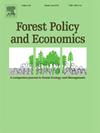Recent trends of employment in the forestry and logging sector of India: Evidence from unit-level data of periodic labour force survey (PLFS)
IF 3.8
2区 农林科学
Q1 ECONOMICS
引用次数: 0
Abstract
The paper examines the recent trends of employment in forestry and logging in India using the Annual Periodic Labour Force Survey (PLFS). The study finds consistent growth in forestry and logging employment during the study period, which is more pronounced in the COVID-19 years and among female workers. Among the sub-groups of forestry and logging, logging activity generates half of the total workers in forestry and logging, with female workers entering the gathering of firewood subgroup in large numbers, reflecting a structural retrogression in forest employment. Silviculture activities are the next component that generates the second-highest employment, followed by the gathering of non-wood forest products, with the gathering of tendu leaves having the highest percentage. Interstate and inter-regional variation is observed in forestry employment, with tribal-dominated states and the Himalayan states having a comparatively high percentage of forest employment as a proportion of total agricultural employment. At the same time, a negative growth rate of forest employment is also witnessed in tribal-dominated regions. Examining the employment type, there is a high level of informality in forest employment, as evidenced by a significant proportion of self-employed and casual labor, with a higher incidence among female workers. The employment elasticity of the forestry and logging sector in most states has room for improvement. Strong economic fundamentals, such as social sector investment and rural literacy, are positively impacting forest employment. Improving the market access of forest products, especially NTFPs, and fostering strong forest-industry linkages, along with enhancing social security measures for informal workers in forestry employment, will help realize the full potential of the forestry sector in generating sustainable and productive employment.
印度林业和伐木部门最近的就业趋势:来自定期劳动力调查(PLFS)单位数据的证据
本文利用年度定期劳动力调查(PLFS)研究了印度林业和伐木业就业的最新趋势。该研究发现,在研究期间,林业和伐木就业持续增长,在2019冠状病毒病暴发的年份和女工中更为明显。在林业和伐木分小组中,伐木活动产生了林业和伐木总工人的一半,女工大量进入拾柴分小组,反映了林业就业的结构性倒退。造林活动是产生第二高就业机会的下一个组成部分,其次是收集非木材林产品,其中收集腾杜树叶的比例最高。在林业就业方面,州际和地区间存在差异,以部落为主的邦和喜马拉雅邦的林业就业占农业总就业的比例相对较高。与此同时,在部落占主导地位的地区,森林就业也出现负增长。从就业类型来看,森林就业的非正规程度很高,自营职业者和临时工的比例很大,其中女工的比例更高。在大多数州,林业和伐木部门的就业弹性仍有改善的余地。社会部门投资和农村识字率等强劲的经济基本面对林业就业产生了积极影响。改善森林产品,特别是非森林保护区的市场准入,促进森林与工业的牢固联系,同时加强对林业就业的非正式工人的社会保障措施,将有助于充分发挥林业部门在创造可持续和生产性就业方面的潜力。
本文章由计算机程序翻译,如有差异,请以英文原文为准。
求助全文
约1分钟内获得全文
求助全文
来源期刊

Forest Policy and Economics
农林科学-林学
CiteScore
9.00
自引率
7.50%
发文量
148
审稿时长
21.9 weeks
期刊介绍:
Forest Policy and Economics is a leading scientific journal that publishes peer-reviewed policy and economics research relating to forests, forested landscapes, forest-related industries, and other forest-relevant land uses. It also welcomes contributions from other social sciences and humanities perspectives that make clear theoretical, conceptual and methodological contributions to the existing state-of-the-art literature on forests and related land use systems. These disciplines include, but are not limited to, sociology, anthropology, human geography, history, jurisprudence, planning, development studies, and psychology research on forests. Forest Policy and Economics is global in scope and publishes multiple article types of high scientific standard. Acceptance for publication is subject to a double-blind peer-review process.
 求助内容:
求助内容: 应助结果提醒方式:
应助结果提醒方式:


